On a clear day, the Castle of Sant’Aniceto appears to float above the Strait of Messina as it basks in the glory of Mt. Etna. Breathtaking panoramas from the medieval fortress extend for miles in every direction. Many liken the castle’s irregular shape to a ship with the bow pointing inland to Calabria’s Aspromonte Mountains.
CASTLE OF SANT’ANICETO, SAN NICETO, SANTO NICETO …
The Castle of Sant’Aniceto’s origins lie in the history of its names, which can be confusing, as the fortification has been called by several. Historic documents mention Santo Nicito, Santo Niceto, Santo Nuceto and Santo Nocito. “Motta Sant’Aniceto” came along at the end of the 19th century, rather recently in the scheme of things, by way of a study of four mottes (a hill serving the site of a castle) in the area of Reggio Calabria. The name Sant’Aniceto caught on.
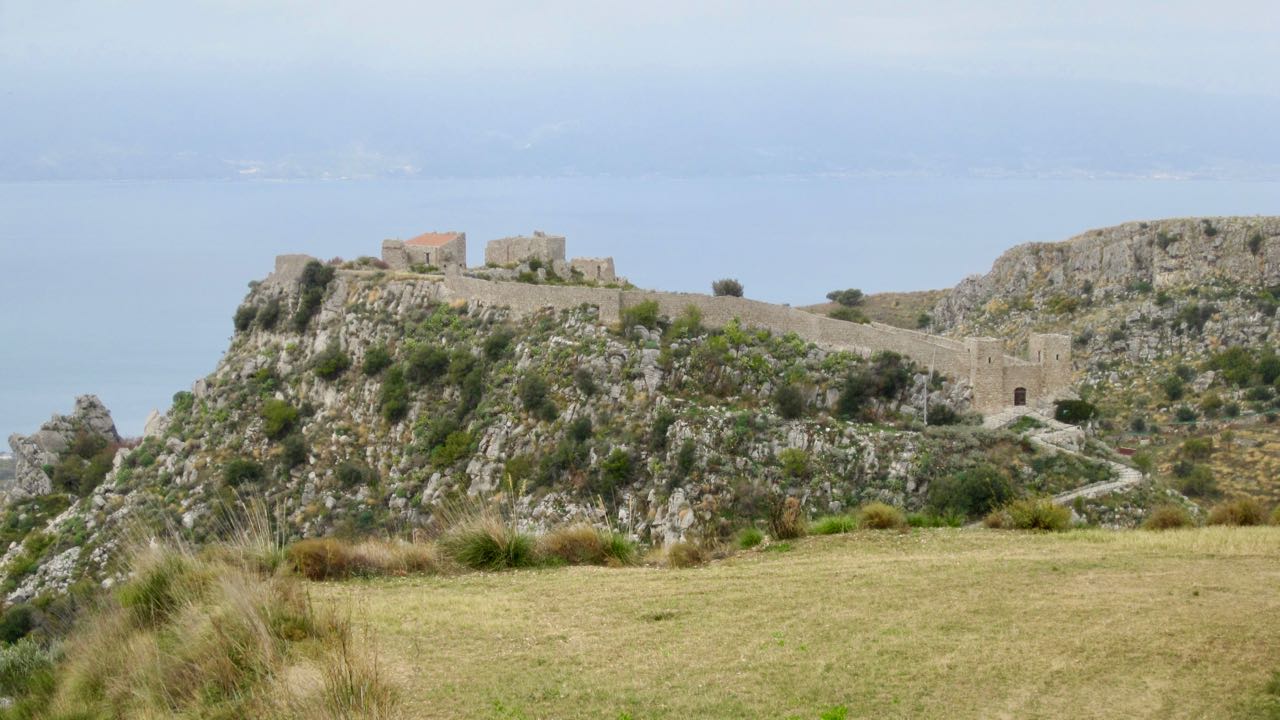
The Castle of Sant’Aniceto with the Strait of Messina and Sicily in the background haze
The original Greek sources, on maps and in documents, however, refer to Hagios Nikitas (Saint Niceto) as the name of the castle and its surrounding territory south of Reggio, where the Greek language was widespread. And in fact, the first fortification was constructed by the Byzantines at the beginning of the 11th-century and named for Hagios Nikitas, the Byzantine admiral who lived between the 7th and 8th centuries, and was greatly admired in Sicily. When the Arabs conquered the island, his followers fled across the Strait bringing their devotion with them and naming the fortress after their saintly protector.
This Byzantine kastron, as such defensive and administrative outposts were called, was built as a lookout post and place of refuge from the frequent Saracen attacks up and down the Calabrian coastline. Interestingly, there was also a community at the foot of the castle as evidenced by the remains of four Byzantine churches built between the 9th and 14th centuries.
THE CASTLE OF SANT’ANICETO OR SANTO NICETO OVER TIME
The Castle of Sant’Aniceto, to use its most common English name, was successively modified and fortified over the the next five-hundred years. The Normans and the Hohenstaufens came on the scene in the 12th century and added a keep, a cistern and a residential edifice. Then, the Angevins, beginning in the 13th century, built an interior defensive wall as well as a chapel. A third protective enclosure was built in the castle’s interior in the 14th century. The castle was eventually abandoned in favor of other fortifications in the area.
How could anyone ever abandon that view, the reader may be thinking, not to mention walk away from such a strategic position. Rest assured, people didn’t vacate the spot completely. A large millstone was found in one of the churches outside the walls. And people were working in the surrounding olive grove during my visit. Life goes on.
A TOUR OF THE CASTLE OF SANT’ANICETO (SAN NICETO) IN MOTTA SAN GIOVANNI
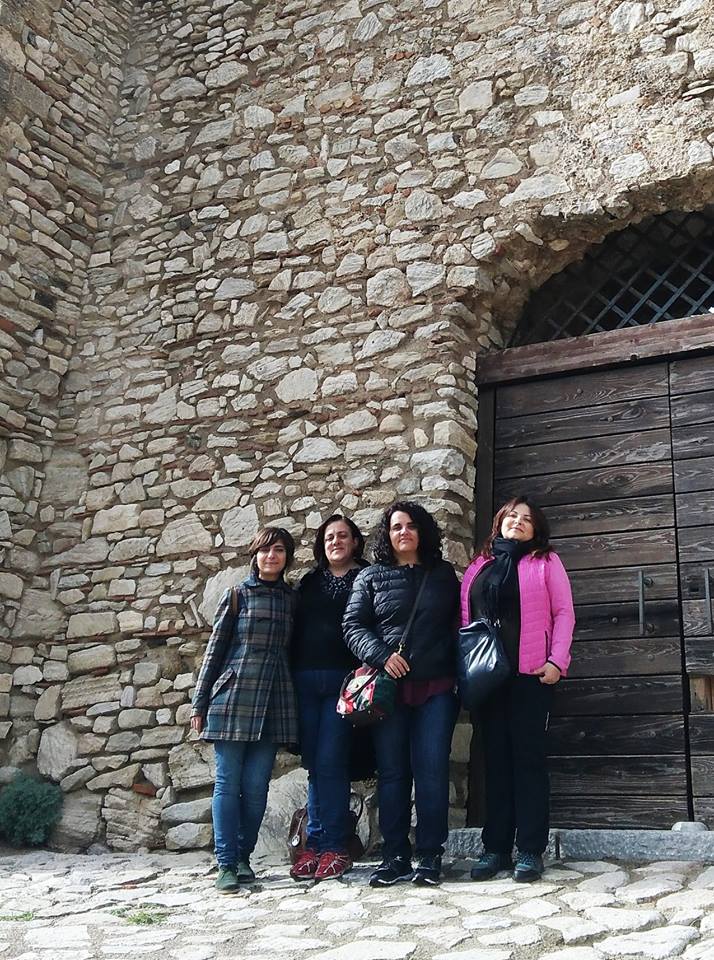
At the castle with Vincenza Triolo and members of Ìmmasto, Giusy Modaffari, Maria Teresa Zumbo and Lucia Albano
I was fortunate to take a tour of the Castle of Sant’Ancieto with a proud citizen of Motta San Giovanni, the town in whose territory the fortification lies just south of Reggio Calabria. Vincenza Triolo impressed me with her passion and breadth of knowledge from the moment she began to speak. She lived and breathed the history of her town.
Vincenza’s enthusiasm came from her grandfather, who would tell her stories of Motta San Giovanni and the castle that had been passed down to him. He delved into modern as well as ancient history. At school, whatever subject she happened to be studying, she would use her town as the topic of research. She earned university degrees in architecture and historic preservation. She was curious to discover if her grandfather’s stories were based on facts or merely colorful legend, and she would find out that everything he had told her was true. He couldn’t read or write.
We began our tour at the main square of Motta San Giovanni, which is about 25 kilometers (16 miles) driving distance from the center of Reggio. From there, we followed signs to the San Basilio section of town for two kilometers, and then turned left for about another three kilometers to the castle. The road is not straight, but typical rural driving in Italian hills.
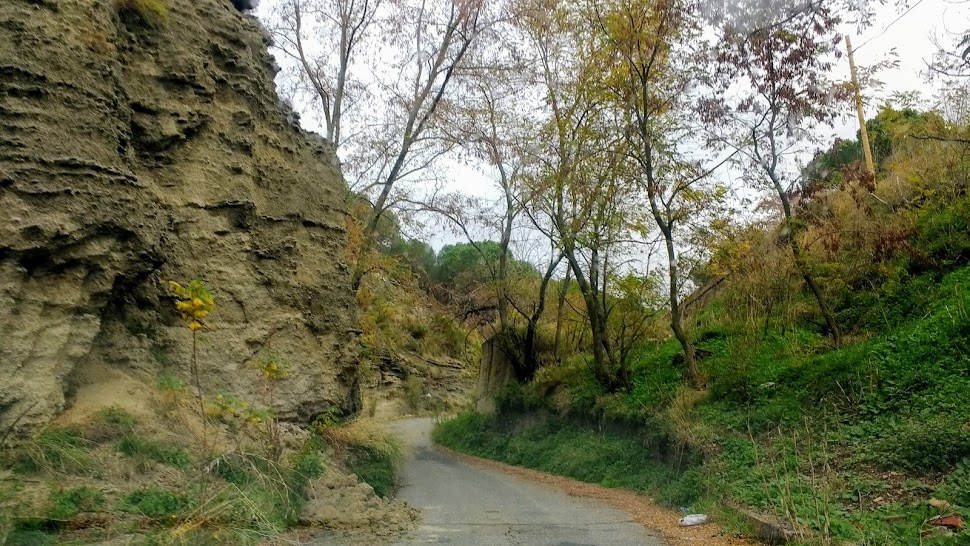
On the road to the Castle of Sant’Aniceto or San Niceto in Motta San Giovanni
At a certain point, I could see the castle at a distance, perched 670 meters (2198 feet) above the Strait. Sicily was just an outline in the haze. The fortified walls followed the shape of the rocky outcropping, a formidable barrier in itself, 55 meters wide and 180 meters long (60 x 197 yards). Today, a path with a handrail leads from the parking lot up to the fortification. Prickly pear cactus and other Mediterranean plant life cling steadfastly to the jagged stone slopes.
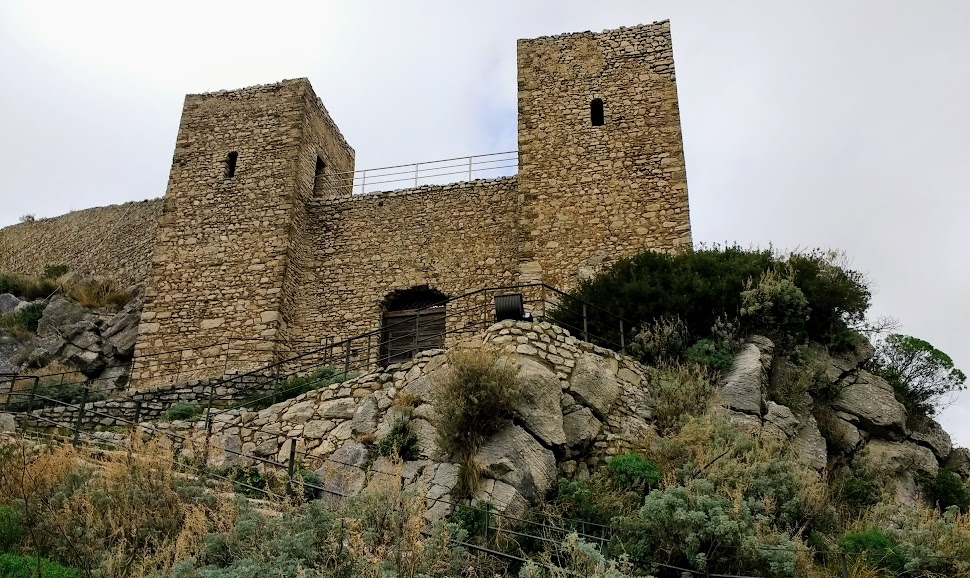
Entrance to the Castle of Santo Niceto
VIEWS FROM THE INSIDE OF THE CASTLE OF SANT’ANICETO (SANTO NICETO)
Rugged on the inside and out, greenery abounds between the thick castle walls. The structure has been restored for visitors to walk fairly safely amongst the ruins. One of the buildings has even been renovated and would make a spectacular conference or wedding location, although I’d recommend changing into heels upon arrival. The view of the Strait of Messina and Sicily with Mt. Etna on a clear day is priceless.
Looking north, I was surprised at how close Reggio was, only 10 kilometers (6 miles) as the crow flies. Just past the craggy hills, I could see the airport runway, and the city unfolded from there.
We walked around the interior for at least an hour. Vincenza made the history of this High Middle Age fortification come alive, from the original structure with its garrison to the successive interior enclosures, perimeter reinforcements, and the addition of the internal edifices and church to adapt to the citadel’s expanded functions.
I thought that perhaps the fortress’ position, one of the most breathtaking in all of Calabria, but also one of the most strategic, really does bring the ideals of the saintly admiral into play. After all, the Castle of Santo Niceto began with the Byzantines, who built a fortification bolstered by a Greek saint. It’s as if the ship that so many see in the castle’s form came directly from the volcano and landed in safety across the Strait, from where the admiral’s disciples held vigil.
Perhaps I am letting my imagination run away with me, but the vision of Mt. Etna, which can practically be touched from the castle mound, is heavenly.

Castle of Santo Niceto, © Massimiliano Pedi
Thank you to Massimiliano Pedi for permission to use his stunning photo of the Castle of Santo Niceto and snow-capped Mt. Etna at dawn (copyright ©). Follow him on his Long Exposure – The M. Pedi Photography Facebook page.
Additional thanks to Vincenza Triolo (Castello di Santo Niceto – Città di Motta San Giovanni) and the Ìmmasto cultural association.
Looking for other places to visit in the area? Here are a few suggestions on my blog: The Castle of Amendolea: A Ghost Town in Calabria, Gallicianò: Greek Culture in Calabria, Pentedattilo: A Ghost Town in Calabria, Palizzi: Yesterday and Day, Archeological Museum in Reggio Calabria, Palazzo della Cultura in Reggio Calabria.
And for an in-depth look at the beautiful land in the toe of the boot, check out Calabria: The Other Italy, my non-fiction book about daily life, history, culture, art, food and society in this fascinating southern Italian region, described by Publisher’s Weekly as “an intoxicating blend of humor, joy, and reverence for this area in Italy’s deep south,” and explore Calabria’s northern neighbor in my book Basilicata: Authentic Italy, “recommended to readers who appreciate all things Italian” by the Library Journal. Available in electronic and paperback versions. Interested in visiting Calabria? Check out the itineraries of my Calabria Tours.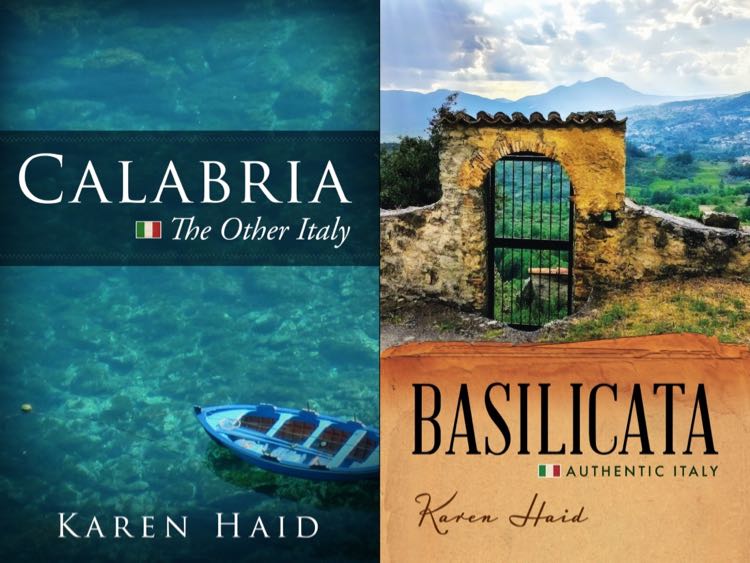
“Like” Calabria: The Other Italy’s Facebook page and follow me on Karen’s Instagram and Karen’s Twitter for more beautiful pictures and information.
Sign up below to receive the next blog post directly to your email for free.





Comments 14
Wonderful tour with you Karen – thank you!
Author
My pleasure – glad you came along!
A fantastic photo of the castle AND Mt Etna!
Also, the stone wall construction is amazing. One can just imagine the people (men?) of centuries past, painstakingly fitting all the rocks & stones side by side, to create each wall!
Thanks for another interesting article!
Author
I love old stone walls, too.
I’ve never heard of this castle! The view of Mt Etna is amazing. Thanks for sharing this place with us. I love discovering new places in Calabria.
Author
It seems as though there’s another castle with a view around every corner of the region. Glad you liked it! (Or as they say in my neck of the woods, “What’s not to like?!”)
Stunning view!
Author
Agreed!
Wow that view! How incredible it must have been for Vincenza to investigate her grandfather’s stories. I would love to hear what sort of stories he told her, which instigated her to discover whether they were true or not.
Author
Many of his stories were historical in nature, but were told in a captivating way, as though he was passing down ancient legends, from what I understand.
Hope to visit Calabria within the next year. This castle would be a fascinating stop-off. And what a view! Thanks for sharing!
Author
Heel to toe, sounds good. And Etna is especially picturesque when it’s covered with snow.
Your photos are awesome! I feel like I was there with you. Che bello!
Author
Thanks, I was really pleased that the photographer of the stunning cover image granted me permission to feature his photo on my post. The other, simpler photos are mine…